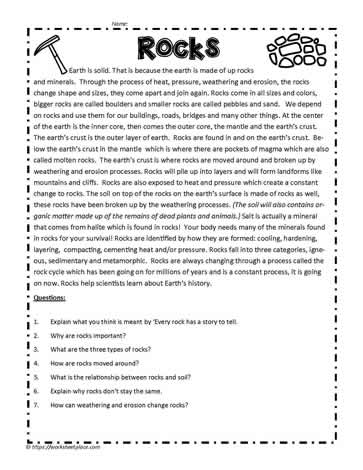| |||||
| Rocks Comprehension Activity For Google Apps | |||||
| The earth is solid because it is made up of rocks and minerals. Find out more info regarding rocks as you read this short blurb. Questions at the end will prove comprehension of the paragraph. Earth is solid. That is because the earth is made of up rocks and minerals. Through the process of heat, pressure, weathering and erosion, the rocks change shape and sizes, they come apart and join again. Rocks come in all sizes and colors, bigger rocks are called boulders and smaller rocks are called pebbles and sand. We depend on rocks and use them for our buildings, roads, bridges and many other things. At the center of the earth is the inner core, then comes the outer core, the mantle and the earth’s crust. The earth’s crust is the outer layer of earth. Rocks are found in and on the earth’s crust. Below the earth’s crust in the mantle which is where there are pockets of magma which are also called molten rocks. The earth’s crust is where rocks are moved around and broken up by weathering and erosion processes. Rocks will pile up into layers and will form landforms like mountains and cliffs. Rocks are also exposed to heat and pressure which create a constant change to rocks. The soil on top of the rocks on the earth’s surface is made of rocks as well, these rocks have been broken up by the weathering processes. (The soil will also contains organic matter made up of the remains of dead plants and animals.) Salt is actually a mineral that comes from halite which is found in rocks! Your body needs many of the minerals found in rocks for your survival! Rocks are identified by how they are formed: cooling, hardening, layering, compacting, cementing heat and/or pressure. Rocks fall into three categories, igneous, sedimentary and met-amorphic. Rocks are always changing through a process called the rock cycle which has been going on for millions of years and is a constant process, it is going on now. Rocks help scientists learn about Earth’s history. Questions: 1. Explain what you think is meant by ‘Every rock has a story to tell. 2. Why are rocks important? 3. What are the three types of rocks? 4. How are rocks moved around? 5. What is the relationship between rocks and soil? 6. Explain why rocks don’t stay the same. 7. How can weathering and erosion change rocks? | |||||

All worksheets are created by experienced and qualified teachers. Send your suggestions or comments.